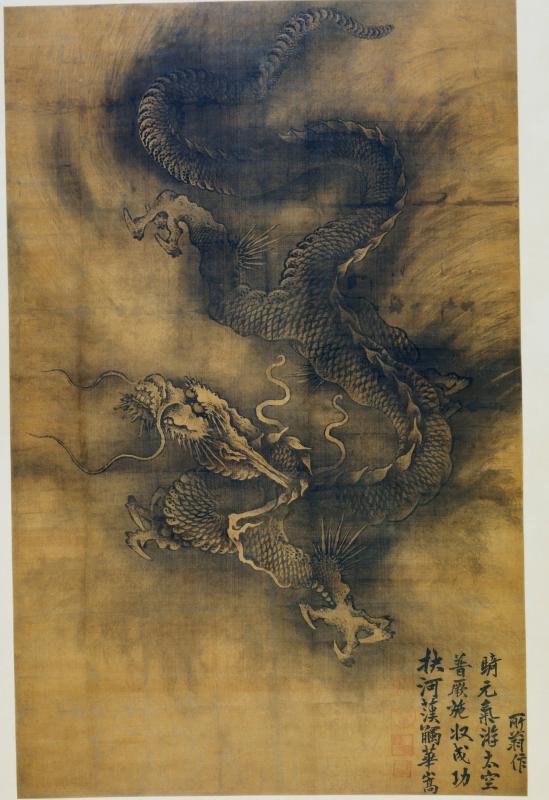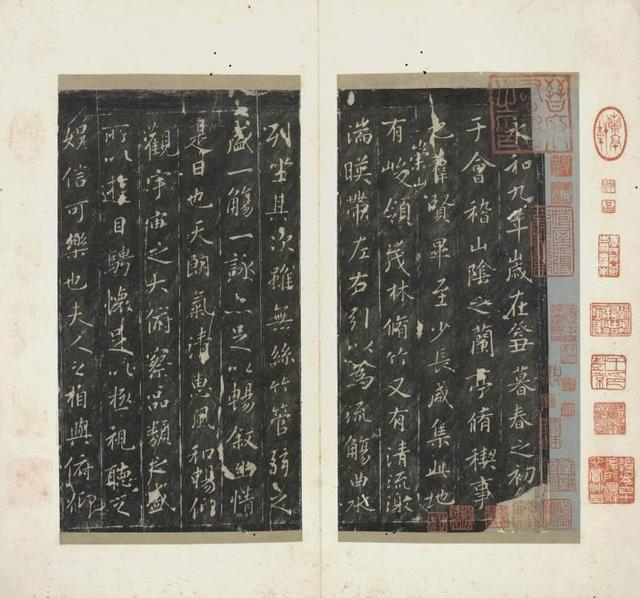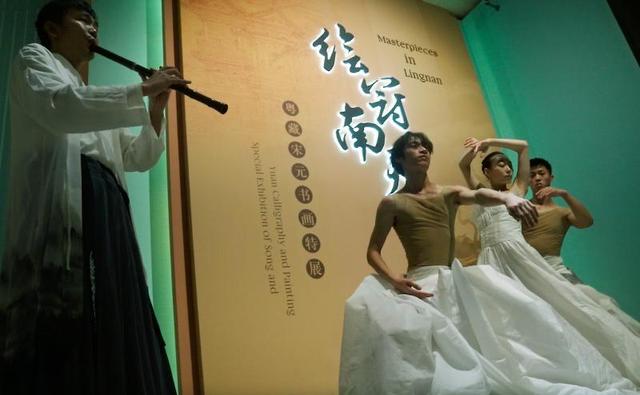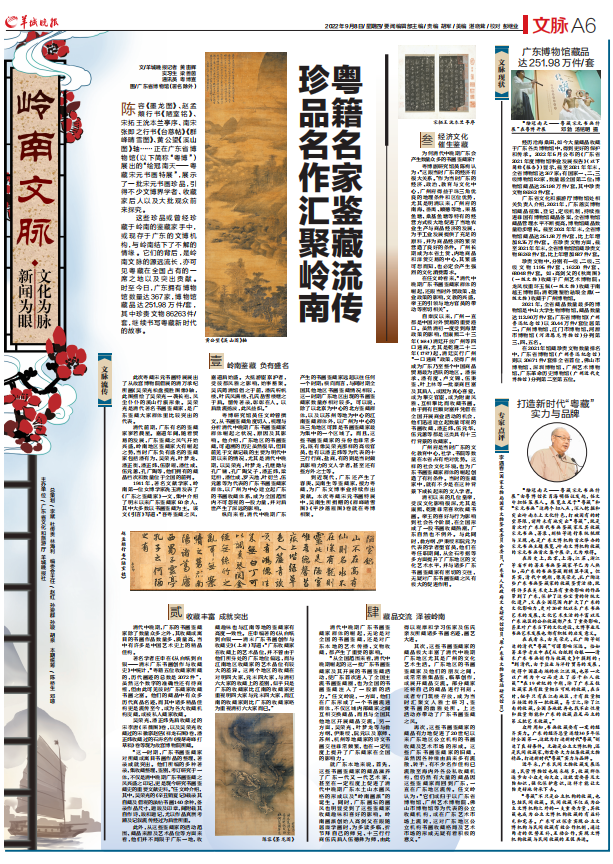"Video" Lingnan Wenmai | Cantonese famous master Jianzhuzhuo masterpieces gathered in Lingnan
Author:Yangcheng Evening News Yangche Time:2022.09.09
Text, Video/Yangcheng Evening News all -media reporter Huang Shanhui intern Liang Shanyin Royal Royal Yin Correspondent Yue Bo Xuan
Figure/Guangdong Museum (except signed)
Chen Rong's "Mo Long Map", Zhao Mengfu's book "Bad Room", Song Tuo Wang Xun Lan Pavilion, the Book of Zhang Shi of the Southern Song Dynasty, "The Snow Snow Map of the Qunfeng", Huang Gongwang's "Xishan Map" axis ... The "Crown Crown Nantian -Guangdong Tibet, Tibet, Song Yuan Special Exhibition" exhibited by the Guangdong Provincial Museum (hereinafter referred to as "Guangdong Bo") shows a group of Song and Yuan Painting and Calligraphy treasures, which attracts many scholars, posterity of collectors, and descendants of collectors and collectors. A large number of audiences come to explore.
These treasures, or in the hands of Lingnan collectors, or the cultural bloggers currently existing in Guangdong, have forged a puzzled relationship with Lingnan. Behind them is the long history of Lingnan Wenmai, and it can also be seen that Guangdong and Tibet have a place in the country and outstanding contributions. To this day, Guangdong has 367 museums, and the museum collection is 2.5198 million pieces/set, of which 86,263 pieces/set of precious cultural relics will continue to write the story of the new era of Guangdong and Tibet.

Huang Gongwang's "Xishan Map" axis
【Wenmai spread】
Lingnan Jianzang is well -known
This time, the special exhibition of the Guangdong, Tibet, and Yuan Dynasty painting and calligraphy exhibited the "Wu Rongguang Songpan Range Rover Image" axis drawn from the Qing Wan Chengji Institute borrowed from the Palace Museum. Image. Wu Rongguang is a well -known collector in the Qing Dynasty, and is a representative of the group of everyone in Guangdong.
In the early Qing Dynasty, there were few Morning Star in Guangdong. During the Jia Dao period, with the development of trade, the atmosphere of Jianzang in Guangdong began to flourish, and the collectors of Lingnan area rose. Pan Zhengwei, Wu Chongzhang, Pan Shicheng, Wu Yuanzhang, Kong Guangtao, etc., they have the grade and number of collections and quantities in the country.
In 1941, the famous literature scholar and the first female scholar Lingnan, Lingnan, published the article "The Collectors of Guangdong", which focused on more than 50 collections in Guangdong since the end of the Ming Dynasty, most of which were based on calligraphy and painting. The article "Introduction" wrote: "The wind of our Yue Jianzhu, Jiadao began to be prosperous. The people who traveled to the Beijing and Shanghai were influenced by the elegance of the other. Listening to Fanlou, Ye's Fengmanglou, and Kong Xuelou followed by. The record is left to the person.
Ren Wenling, a research librarian of Guangdong Bo, wrote an article, cut in from the perspective of calligraphy and painting, sorting out and analyzing the situation, reasons, and influence of the rise of the collectors in the middle and late period of the Qing Dynasty in the middle and late period of the Qing Dynasty. He introduced that although the history of calligraphy and painting in Guangdong, the history of traceability is very early, but it is currently seen in the literature records that are mainly since the middle of the Ming Dynasty, especially in the middle and late Qing Dynasty. Father and son, Pan Zhengwei, Liang Tingzheng, Pan Shicheng, Luo Tianchi, Ye Yanlan, Wu Yuanzhang, etc., such as Guangdong calligraphy and painting book collectors, established the Guangdong calligraphy and painting collection system centered on Guangzhou. Later generations had a profound impact.
Vowbate, the collectors of calligraphy and painting in Guangdong in the middle and late period of the Qing Dynasty far exceeded any previous period; in the horizontal, compared with the painting and calligraphy collections in other parts of the country in the same period, the calligraphy and painting colleagues appeared in Guangdong during this period. The number is also relatively large. It can be said that, in addition to the northern collections centered on Beijing, and the Jiangnan Jianzhi group centered on Suzhou and other places, the Pearl River Delta region centered on Guangzhou can be regarded as the most concentrated area of calligraphy and painting collections. Moreover, the identity of these collectors of these calligraphy and painting identifications is also very diverse. There are both senior officials like Wu Rongguang, as well as the thirteen business merchants and salt merchants represented by Pan Zhengwei. There are even some foreign people.
Nearly modern times, Guangdong also produced Jun Geng, Wu Nansheng and other collectors to relay Guangdong and Tibet, which contributed to the continued contribution of Guangdong's cultural and cultural careers. In this special exhibition of painting and calligraphy in Guangdong, Tibet,,, Tibet,,,, Wu Nansheng donated "Qunfeng Qingxue Map" and "Pingsha Luoyan Map" volume gathered in the Guangdong blog.

Chen Rong "Mo Long Map"
The rich achievements are prominent
In the middle and late Qing Dynasty, in addition to the large number of calligraphy and painting collections in Guangdong, the number of paintings and calligraphy works in collections or visibles was large and high. Many of them were good structures in the history of Chinese art.
The famous scholar Zhuangshen statistics in "From White Paper to Silver -the History of Creative and Collection of Calligraphy and Calligraphy in the late Qing Dynasty", "The total number of paintings in the past of the five collectors of Cantonese is 2072", although this number is accurate Sex is yet to be discussed, but it can be seen that at that time, the Cantonese collector's collection of calligraphy and painting was rich. There are many authentic traces in their collections, and many of them have been circulating to this day, or have been collected for major collective institutions, or they have been collected by private collectors.
Wu Rongguang and Pan Zhengwei have collected Song Li Tang's "Cai Weitu" volume, as well as the "Xianglong Stone Map" volume of Song Huizong Zhao Zong, which was collected by Wu Rongguang, and the masterpiece of Shi Tao's masterpiece "Search for Qi Feng Draft" volume and so on. It is now hidden by the Palace Museum.
"During this period, the collectors of Guangdong calligraphy and painting bookmakers have outstanding achievements and records of the collection and calligraphy works of the hidden or spectacles. They have compiled a variety of records, which integrates collection, identification, and research. The mark of Jianzang's prosperity is an important literary historical material for studying the history of calligraphy and painting. "Ren Wenling introduced, among them, Wu Rongguang's" Xin Chou Summer Summer "records more than 140 articles of calligraphy and painting from Tibetan and borrowed. The size of the work, postscript and seal of the work, and the interceration of their own poems, posts and inscriptions, especially the authenticity and narrative of the work, and the narrative has passed through the past generations. In addition, from the aspects of the scope of activities, collections and artistic tastes of these collectors, they are not limited to Guangdong, and the collection of fun is also highly consistent with collectors in Jiangnan and other places. Zhuangshen's "From White Paper to Silver -Silver -the History of Calligraphy Creation and Collection in the late Qing Dynasty" (above) wrote: "The artistic position of the Guangdong collectors in collections has not been because they are in the remote status they are, and they are remote. There is a large difference from the artworks of collectors in Jiangnan. The differences in the two regions in the four areas of the Ming Four and the Yuan Dynasty, and the collection of the sixth everyone in the early Qing Dynasty. The collectors pay more attention to the Ming Fourth and the Yuan Dynasty, while the collectors of Jiangnan slightly pay more attention to the sixth everyone in the early Qing Dynasty than the Guangdong collectors. "
Zhao Mengfu's book "Bad Room"

Economic and cultural births
Why did Guangdong produce a large number of calligraphy and painting collectors in the middle and late period of the Qing Dynasty?
Chen Yan, an associate research librarian of Yuebo, believes: "This has a lot to do with the economy of Guangdong at that time." As the economic, political, education and cultural center at that time, the Guangzhou government benefited from the excellent geographical conditions and location advantages of the Pearl River Delta. , Especially since the Ming and Qing Dynasties, the Nanhai, Panyu, Shunde and other places in the Guangzhou government, the unique business methods such as fruit -based fish ponds, Sanji fish ponds have greatly promoted the development of the local agricultural production and commodity economy, and provided the development of the handicraft industry to provide the development of the handicraft industry. Successive raw materials have created good conditions for the prosperity of the commodity economy. Guangzhou has long become the center of the province's native goods, mainland goods and foreign goods transactions.
In Ren Wenling's view, "the rise of the Cantonese collectors in the middle and late period of the Qing Dynasty was closely related to the influence of foreign trade policies and salt policies at that time, the prosperity of cultural and education, and the leadership of the emperor was closely related to the driving of local officials."
Since the Qin and Han dynasties, Guangzhou has been an important port for China's foreign trade. Although the early Qing Dynasty was influenced by the sea ban policy, in the 23rd year of Kangxi (1684), the Qing court opened four commercials such as Guangzhou, especially in the 22nd year of Qianlong (1757). This makes Guangzhou the most active region in Guangdong and even the entire Chinese commodity trade. A group of rich wealthy and future generations such as Pan Zhencheng, Pan Youdu, Lu Wenjin, Wu Bingjian, Ye Shanglin, or their descendants, or collected calligraphy and painting for the climbing officer, or to compare each other for the vassals and comparisons each other. Due to the huge wealth and the opportunity to carry out business activities across the country, they quickly established a considerable number of calligraphy and painting collection, Pan Zhengwei, Wu Yuanhua, Wu Yuanzhang, etc. are all such collectors with thirteen lines of background.
The Guangzhou government was the cultural education center of Guangdong at that time. Such a social and cultural environment has also created favorable conditions for the rise of the collectors of the Guangdong Painting and Calligraphy. Many of the colleagues at the time were literati scholars who grew up in this context.
Several emperors since the early Qing Dynasty were deeply influenced by Han culture, especially Kangxi and Qianlong liked collecting calligraphy and painting. The emperor's preferences and behaviors affect all classes of society, and a wave of calligraphy and painting collection has formed in the country, and Guangdong is naturally no exception. At the same time, Weng Fanggang, Yi Bingzhang and Ruan Yuan are scholars. During their duty in Guangdong, they have improved the cultural and artistic level of Guangdong from various aspects and other aspects. Exchange is undoubtedly a great promotion of the customs of Guangdong's calligraphy and painting.
Song Tuo Wang Qi Ben Lanting Preface (Photo Conferry of the Guangdong Provincial Museum)

Tibetan exchanges are in Lingnan
In the middle and late period of the Qing Dynasty, the rise of Guangdong calligraphy and painting collectors, whether it was the national painting and calligraphy nationwide, or the local art communication and cultural relic collection in Guangdong, it had an important impact.
"From the perspective of national perspective, the batch of Guangdong calligraphy and painting collections in the middle and late period of the Qing Dynasty and the calligraphy and calligraphy collections of paintings and paintings carried out in the middle of the Qing Dynasty made Guangdong enter the national mainstream calligraphy and painting collection circle. A new vitality. "Ren Wenling said, on the one hand, they formed a calligraphy and painting circulation group in Guangdong, not only exchanging collections between collectors inside the region, but also to exchange collections with other parts of the country. On the other hand, Wu Rongguang, Ye Menglong, and other poetic, calligraphy and paintings of Tibetans such as Weng Fanggang, Yi Bingzhang, Ruan Yuan, and Jingshi, Suzhou, Hangzhou and other Tibetans are very frequent, and to a certain extent, it has increased the influence of Guangdong collectors in the country to a certain extent. Essence
As far as Guangdong is concerned, first of all, the collections of these collectors of calligraphy and painting nourish the Guangdong generations of artists, and even promote the formation of the style of Guangdong's local landscape painting style in the middle and late period of the Qing Dynasty and the birth of the "Lingnan Painting School". At the same time, the style of painting in Guangdong's painting world is also obviously affected by the collection of these collectors' collection and preferences. When the founder of Lingnan Painting School, Gao Jianfu, when he studied paintings, read more, and worshiped his brother and the descendant of Wu Deyi, the descendant of his brother Wu De, who was able to observe and learn the Wu family. Many famous paintings and calligraphy are collected by relatives and friends of Wu family. Secondly, the collections of these collectors in calligraphy and painting greatly enriched the cultural and artistic life of Guangdong in the middle and late Qing Dynasty, especially Guangzhou. Between the collectors of the calligraphy and painting in Guangdong and their friends, they often collect tasting, copy creations, or exchanging collections. Some collectors also published their own collections, or specially built buildings, and became the elegant place to gather literati to study and appreciate painting and calligraphy at that time. The above -mentioned activities have also led to the style of Guangdong calligraphy and painting.
Again, the collection of these collectors in calligraphy and painting has strongly promoted the formation of calligraphy and painting collection and art markets of public institutions in Guangdong since the 20th century. Although the old collection of these Guangdong calligraphy and painting collections, although there are many dispersion and transfer of hands due to various reasons, many famous works have flowed to various public and private collections at home and abroad, but there are still a large number of collections. Back to Guangdong, it has been circulating in Guangdong. Ren Wenling believes: "They may be classified as a public collection institution represented by the Guangdong Provincial Museum, the Guangzhou Art Museum, and the Foshan Museum, or the circulation of the Guangdong art market. It has positive significance. "
【The Status of the Pulse】
Guangdong Museum Collection reaches 25.198 million pieces/set
After experiencing the vicissitudes of the sea, a large number of collections are now collected in various museums in Guangdong, which has been better protected and inherited. The "Guangdong Provincial Museum Career Development Report" (hereinafter referred to as the "Report") released in May 2022 shows that as of the end of 2021, there were 367 museums in the province; The second place in the country; the museum collection is 25.198 million pieces/set, of which 86,263 pieces/set of precious cultural relics.
According to the relevant person in charge of the Museum of the Guangdong Provincial Culture and Tourism Department, in 2021, Guangdong implemented the collection, registration, and grading mechanism of the museum collection, continuously promoting the filing of non -state museum collections, the level of collections of museums in the province continued to increase, and the number of museum collections increased steadily Essence As of the end of 2021, the province's museum collections reached 2.5198 million pieces/set, an increase of 87,500 pieces/set over the previous year. In terms of precious cultural relics, as of the end of 2021, 86,263 precious cultural relics/sets of museums across the province increased, an increase of 887 pieces/set over the previous year.
Among the precious cultural relics, there are 1,195 pieces/sets/set, 16,220 pieces/set, 68048 pieces/set. For example: Gao Jianfu's "Autumn Eagle Map" (first -level cultural relics) is collected in the Guangzhou Art Museum; Longfeng pattern heavy ring jade pendant (first -class cultural relics) is collected in the King of King of South Vietnam; At the Guangzhou Museum.
In 2021, the most collected museum in the province was the Sun Yat -sen University Biology Museum, with a collection of 1.139 million pieces/set; the Guangdong Museum (Guangzhou Lu Xun Memorial Hall) ranked second in 204,400 pieces/set; the Guangzhou Museum and Jiangmen Museum Museum The Heyuan City Museum (Heyuan Dinosaur Museum) is ranked third, four, and five.
In the ranking of the number of precious cultural relics in 2021, the Guangdong Provincial Museum (Guangzhou Lu Xun Memorial Hall) ranked first in the province with 20,671 pieces/set. List second to fifth place.
【Expert Reviews】
Create the strength and brand of "Guangdong Tibet" in the new era
Li Yuchun (member of the State Cultural Relics Bureau of the State Cultural Relics Appraisal Committee, a librarian of the Cultural History Research Museum of the Guangdong Provincial People's Government, and former research librarian of the Guangdong Provincial Cultural Relics Appraisal Station)
"Painting Nantian -Special Exhibition of Calligraphy and Painting and Calligraphy in Guangdong, Tibet, Tibet, and Song," Xiao Haiming, the director of the Guangdong Expo, was initiated, and Ren Wenling served as the curator. The exhibition is based on the two entry points of "Guangdong Tibet" and "Song and Yuan Painting and Calligraphy", in -depth excavation and highlighting the local cultural characteristics of Lingnan, and breaking the inherent limit of time and space. Home and its collection of Song and Yuan dynasties, calligraphy, calligraphy, records, and engraving are carried out and presents. It is also the first time that the Song and Yuan Dynasties theme exhibitions of the Song and Yuan dynasties organized by the Guangdong Cultural Expo Agency and the first centralized display of Song and Yuan painting and painting in Lingnan Wenbo Institutions were particularly rare.

Historically, well -known calligraphy and calligraphy collections in Beijing, Shanghai, Jiangsu, Zhejiang and other provinces and cities have long been well known, while Guangdong's calligraphy and painting collections are slightly bland. But in fact, in the middle and late Qing Dynasty, the collection and appreciation activities of Cantonese paintings such as Wu Rongguang and Kong Guangtao brought many works that have important influences in the history of art to Guangdong, protecting these valuable traditional cultural heritage, and it was also in The national influence of Guangdong has been expanded nationwide, and it has also had an important impact on the development of Guangdong's calligraphy and painting art since the 20th century, the richness of cultural and artistic life, and the public and private collection in Guangdong. The development of calligraphy and painting art has also positively inspired. In my opinion, the "Guangdong -Tibet" created by Wu Rongguang and Kong Guangtao can be described as far -reaching. As the famous scholar Zhuang Shen mentioned in "From White Paper to Silver -the History of Calligraphy and Creation and Collection in the late Qing Dynasty": "In the Qing Dynasty, due to the development of the salt industry and the foreign bank trade, the southernmost Pearl River Basin in China also made For the first time, a number of private collections were established with Guangzhou as the center. "" In the middle of the 19th century, except for the five collectors in Guangdong had considerable collections. At that time, it seemed that only in the Jiangnan region, there was a considerable number of approaches. A group of collections. In short, except for the collection of Jiangnan, all parts of the country can no longer find the third batch of art collections that can be established with Guangdong's collection. "
As we all know, the collection of calligraphy and painting must have a certain economic strength. The total economic volume of Guangdong has maintained the country for more than 30 consecutive years, which has created good conditions for creating the "Guangdong -Tibet" in the new era. Whether it is a public civilian institution or a civil collector, it is necessary to vigorously solicit the collection of cultural relics to create the "Guangdong -Tibet" strength and brand in the new era.
In recent years, Guangdong's private cultural relics collection has developed rapidly, and there are more and more private museums. The collection groups have gradually moved from niche to the public. This requires popularization of cultural relics and strengthening awareness of protection, so that the cultural relics can be better inherited.
"Guangdong Tibet" is not only the collection of public institutions, but also private collection. Civil collections have not only become an important force outside the public cultural and Expo institutions, but also have also become the useful supplement and improvement of the collection of public cultural and open institutions. Guangdong can explore the effective cooperation mechanism of public cultural and bloggers and private collections. Through the advantages of the two, the two are complementary and interactive cooperation to achieve the mutual promotion and co -promotion of the collection of cultural and blogging institutions.
"Painting Nantian -Special Exhibition of Painting and Calligraphy in Guangdong, Tibet, Tibet, and Song, Yuan, and Painting and Painting," Photo Photo of Deng Bo Tang Mingming in Guangdong Bo
【Guangdong Tibet everyone】
1. Wu Rongguang

Wu Rongguang (1773-1843), a native of Nanhai, Guangdong, a poet in the Qing Dynasty, collectors of calligraphy and painting, and Jinshi scholars. Calligraphy is important. His teacher inherited Weng Fanggang and Ruan Yuan, served as the governor of Hunan, Governor of Huguang, and Fujian administration and other important positions. , Li Tang's "Cai Weitu" and many other masterpieces. After returning to his hometown after his post, he played an important role in the rise and development of Guangdong's collection culture.
Wu Rongguang is the official for thirty years. The experience in Jiangsu and Zhejiang make its vision, communication, and collection wide. Its collection has a distinct system, and it also records its hidden, seen, and heard in detail in the writings such as "Xin Chou Sales Xia Ji". His influence on Guangdong culture is far -reaching, and the most intuitive reflection is in his collection. "Xin Chou Sales Xia Ji" has become a must -read book for many Lingnan collectors. The Tibetan culture in Lingnan has a profound impact.
Two, Rong Geng
Rong Geng (1894-1983), a native of Dongguan, Guangdong, a well -known ancient literaryist, archeologist, collector, calligrapher. He has successively served as a professor at Yanjing University, Lingnan University, and Sun Yat -sen University. A large number of bronze wares, ancient books, paintings and calligraphy, oracle bones, goldstone paddles, cluster posts, celebrities, etc.
In his later years, Rong Geng adhered to the idea of "cultural relics is the public instrument of the country", and donated his life to the country one after another. In 1956, there were 95 bronze wares, 21 pieces of calligraphy and painting in the Guangzhou Museum, and a batch of bronze wares and oracle bones unearthed from Yin Ruins; in batches donated paintings and calligraphy to Guangzhou Art Museum in batches, totaling 1083 pieces (sets). In 1975, 13 large oracle bones were donated by the Institute of History of the Chinese Academy of Sciences. In 1980, it donated more than 130 boxes such as the text, calligraphy and painting, ancient literature research books, ancient literary research books, ancient books, and extension.
In 1998, the family members donated 460 cultural relics such as the ancient books of the Guangdong Library of Guangdong Province, the golden stone picked film, the celebrity ruler, the letter of the book, the bookbook, the book, and the manuscript. Ancient Chinese Character Research Institute.
The original article was published on September 8, 2022, "Yangcheng Evening News" A6 Edition
General Planning/Li Bin Du Chuangui Lin Haili
Editorial Director/Zhao Hong Sun Aiqun Sun Xuan Hu Quan

In this issue/Chen Qiansheng Deng Qiong
Organizer/Guangdong Provincial Culture and Tourism Department Yangcheng Evening News
Source | Yangcheng Evening News • Yangcheng School
Editor -in -law | Hu Jun
Edit | Li Li
- END -
Create East Asian Capital 丨 Experts and Scholars talk about non -genetic inheritance protection

Intangible cultural heritage is both a testimony of historical development and val...
Member of the Shanghai Municipal Committee of the CPPCC builds the work of the protection and utilization of Shanghai Industrial Heritage
As the birthplace of the Communist Party of China, Shanghai is the cradle of modern Chinese industry and the birthplace of the Chinese workers' movement. It carries a large number of industrial herita...